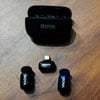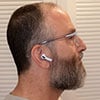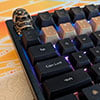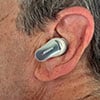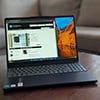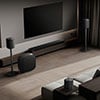We may earn commissions when you buy from links on our site. Why you can trust us.
Bose QC Ultra Earbuds 2 Review – Subtle Changes, Major Payoff
There’s little dispute in the audio community that Bose is the master of Active Noise Cancellation (ANC) technology, regularly winning top honors for noise shushing with its compact, ANC-equipped earbuds and full-sized headphones. Bose first introduced the concept of ANC to the consumer headphone category a quarter of a century ago and has been steadily improving on the species.
But many a product rival has been nipping at its heels in recent years, offering “almost as good” ANC while equaling or surpassing Bose in other aspects. Apple is claiming “best ANC” performance with its just announced AirPod Pro 3 earbuds, due out September 19. I'll let you know when I test them out.
Read more: Apple’s AirPods Pro 3 Claim World’s Best Noise Cancellation
So this season, not resting on its laurels, Bose hopes to hang onto the crown with its newly launched QuietComfort Ultra Earbuds 2nd Gen ($299). And yes, they are delivering notable improvements on several counts – offering a more refined musical balance, significantly better phone call sound, and an enlarged utilities set, including in-case wireless charging. And all that’s on top of Bose’s proprietary CustomTune processing for ear measuring/adjusting and a growing set of sound contour options. And they are the best ANC earbuds on the market.

| + Pros | – Cons | ||
|
|
||
|
|||
Design and Controls: Looks Are Deceptive
At first glance, you’d easily mistake the 2nd Gen buds for their predecessors, which debuted in 2023. The unique, ergonomic shape of the buds, form-fitting with swappable silicone tips and bumpers to sit securely in the inner bowl of a wearer’s ears, has not changed. But on close inspection, you will notice a new, perforated grill at the ear tips’ outer end, where before there was just a gaping hole.
Bose characterizes that perforated grill as a “wax guard.” Its stated mission is to prevent ear schmutz from slipping into the earbuds’ recesses – a potential sound disrupter. If trying to scoop out said schmutz with a toothpick, it’s terribly easy to do permanent damage to the drivers. But it ain’t gonna happen no more on these newbies! (FYI - Original QC Ultra bud owners should consider buying and installing a “Fit Kit” of compatible Ultra 2 replacement tips, when available.)
Though not touted, I’m also thinking the grill work is contributing to the improved sound I’m hearing out of this second-gen model. The covers are not that different in spirit from the crosshatch grills that speaker makers sometimes affix in front of tweeters, primarily for physical protection (they’ll claim) but also serving to reduce acoustic interference, especially at high frequencies, by carefully controlling diffraction. The grill work evens out the sound wave dispersion, in the process reducing signal clash and coloration.
Significant tweaking to the digital algorithmic tuning of the 2nd-gen buds is the primary cause of the sonic improvements, of course. In direct A-B comparisons, with the EQ controls left in the “flat” (factory default) tuning position, the new buds do sound better balanced than their predecessors – neither too showy nor undernourished in any regard. In a word sweet! They’re a satisfying touch or two brighter, without veering into hard, harsh, and fatiguing territory. At the same time, bass bulge (but not bass clarity) is backed off a tad from the prior model, so the earbuds’ sound signature is not as “Bosey” - my term for the toasty warm coloration that’s distinguished lots of the makers’ products to the pleasure of many but the disdain of others.
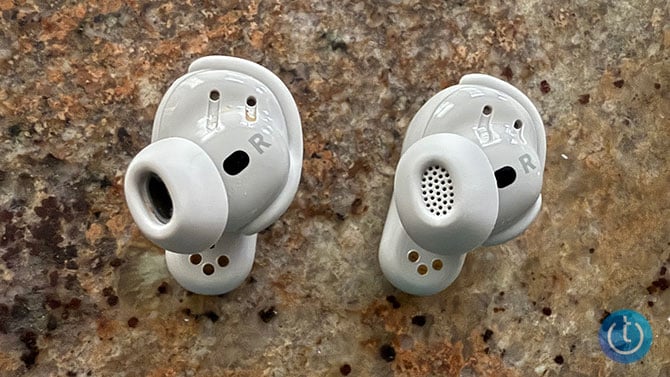
Wax-shielding grills debuting on the 2nd Gen buds (right) save the bother of cleaning and may contribute to the enticing sound.
The 2nd Gen’s carry/charge case could likewise pass for “same as it ever was.” But the brand logo is a tad larger (so Bose-aholics can tell their latest acquisition apart from their last?) and the case is a hair thicker. That’s to pack in the new wireless charging circuitry, so you can just plop the package down on a Qi charger to replenish the battery power. Works fine when you line up the pairing/reset button on the back of the case with the hot spot center of your charger.

It takes an eagle eye to differentiate the 2nd Gen QC Ultra Earbuds package (right) from their predecessor (left), unless you opt for the newbies dressed in a limited edition Deep Plum tone. White Smoke (shown here) and Black are the perennial options.
New and exclusive to the Ultra Earbuds 2nd Gen is an optional remedy for the ultra-sensitive capacitive touch controls hiding in the buds’ decorative trim plates. Tricky to use, just the slightest touch or slide of a finger triggers the controls to do their things – raise/lower the volume, pause the music, skip to the next track, answer or end a call. And sometimes (okay, often) when I’m adjusting how the buds are seated in my ears, I inadvertently cause the music to pause or (worse) hop prematurely to the next track. So what’s the solution? Now there’s a menu-accessible option to turn off those touch controls. Of course, users will then need to pick up a call, adjust the volume, or skip around in the playlist using the controls on their connected smartphone, computer, or smartwatch screen.
Read more: Nothing Headphone vs. Sony XM6: Surprising Wins and Clear Trade-Offs
Audio Quality: Testing, Testing
I listened to lots of acoustic-instrument-focused musical pieces (jazz, folk rocking, classical) to make my sonic judgment call. An Apple Music playlist of ultra-familiar pop classics – ranging from Aretha Franklin’s “Respect” to Frank Sinatra’s “The Lady is a Tramp” – underscored how thoroughly revealing and well-balanced these things perform. Geez, those old recordings still sound fresh, if you play ‘em right.
For direct comparison of first and 2nd Gen Ultras, I relied on multiple cycles of my favorite track from Molly Tuttle’s freshly mowed newgrass album So Long Little Miss Sunshine. Fetched in high res from Qobuz, “Summer of Love” is a treat to the ears, invoking both Fleetwood Mac’s populist hits and the “Flower Power” protest music of the late 1960s. Think clarion call vocals, strummy/resonant hollow body guitar, dabs of shimmering synth, snappy drums, and heartbeat bass.
The soundstage of the Ultra Earbuds 2nd Gen grows even airier and certainly more three-dimensional when you click on the Immersion processing option – Bose’s homegrown, works-with-anything take on “spatial audio” - and summon up a concert recording like Nina Simone – The Montreux Years. Without the processing engaged, the set could just as well have been recorded in a studio. You feel nose-to-nose with the soul/jazz chanteuse and her band. But with Immersion activated, you experience a far more exciting live show in a resonant concert hall from a plum location, 10th row center seat.
Enhanced clarity and presence likewise rewarded when I tried out Bose’s new Cinema sound processing mode that’s making its debut on the Ultra 2 earbuds (and coming on the 2nd Gen QC Ultra Headphones). Cinema activation proved helpful for decoding the posh British speech of Helen Mirren, Pierce Brosnan, and Ben Kingsley on a fluffy new Netflix film offering The Thursday Murder Club playing on my iPad Pro. No need to turn on subtitles! Mumbling podcasters will likewise communicate better, I’d wager, in Cinema mode.
BTW – there’s no need here to fuss with device switching in the Bose app. Bluetooth Core 5.3 supports multipoint connectivity, staying connected to two source devices simultaneously. Other on-board linking options include Bose SimpleSync, Google Fast Pair, and Spotify Tap, with codec support for Advanced Audio Coding (AAC), aptX Adaptive (Snapdragon Sound), and Low Complexity Sub-band Coding (SBC).
Call Quality: Can you hear me now? And how!
So-so phone call quality was the biggest complaint about (and score reducer for reviewers) with the first-gen QC Ultra earbuds. But with their second coming, a gauzy veil has been lifted. Swapping buds mid-call between the two models demonstrates a dramatic improvement. One pal on the other end of a call asked if I’d switched from a speaker phone to a high-end wired headset. Another noted, “You sounded at first like you had a bad cold, a raspy sore throat. Now you sound healthy. What a miraculous recovery.” Maybe even better tweaks were noticeable on my side of the conversation after I switched from the first to the second-gen QC Ultra buds. The party to whom I was speaking got louder and clearer in my ears; they now seemed to be speaking in the same room rather than from a faraway locale.
Bose credits this newfound clarity of conversation to “a new AI-powered noise suppression system,” which “improves call quality when combined with the earbuds’ eight microphones, dynamic mixing, and adaptive filters. Leveraging Bose audio augmentation technology originally developed for hearing aids, the earbuds effectively reduce background distractions – like wind or office chatter – whether using one earbud, or both, while keeping the speaker’s voice front, center, and clear.”
And here’s good news for original Ultra Earbuds owners: this new set of voice pickup and playback refinements, dubbed Bose Speech Clarity, is also coming (or may already be available as you read this) as a free software upgrade to the first-gen QC Ultra Earbuds.
Battery life: Just Keeping Pace
You can expect six hours of continuous use (four with the Immersive mode activated) at mid-level volume before the buds need recharging in their case. That’s just about as long as I can wear them without needing an ear-resting “time out.” Twenty minutes of in-case residence will then fast charge them for two hours additional use; a full charge of the buds takes two hours. The case itself (which holds up to 18 hours of backup battery juice) requires three hours of charging to fully charge.
Things still to resolve?
Hopefully, a couple of other concerns I’ve encountered with the Ultra Earbuds 2nd Gen’s CustomTune sound calibration can be worked out with software updates. The maker is touting an “updated algorithm” and improved “ActiveSense experience” that’s supposed to kick in when listening in Aware Mode. This processing is meant to “filter out sudden spikes of noise, preventing audio content from being drowned out by the sound of a passing train or nearby siren.” But on my urban walkabouts, that noise muting has been modest.
Gripe two relates to how the CustomTune sound calibration process samples and contours the sound (and drops the noise floor to practically zilch) when you remove the earbuds from their case and push them into your ears. That’s all well and good. But then, when you move into a new environment – say, hopping onto a bus – the CustomTuning is no longer functioning at the optimum level. There’s too much engine noise! Too much people chatter! To fix this first-world problem, I’ve learned to return the buds to their case temporarily, let them sit and settle for a few seconds to recover their composure, then pull them out and pop them into my ears again. Now they’re operating at peak ANC power again. I’m thinking it would be nice if re-tuning could just be triggered instead with just a voice or touch command.
Bottom Line: My Favorite ANC Earbuds
To paraphrase the once and forever Fab Four, the Bose QuietComfort Ultra Earbuds (2nd Gen) present us an excellent study in product tweaking, taking “a glad song and make it better.” Their sound stage retuning is subtle but effective. Their performance with phone calls is remarkably improved. Bose’s custom take on “spatial” processing is arguably better than rivals’ because it can work magic on ANY content. The new Cinema mode will be a blessing for anyone who complains (who doesn’t?) that films and TV shows have muffled dialogue. Doubtless, other earbud makers will look at the QC 2nd Gen’s new wax guards and say, “We need to do that.” Combine all that with Bose’s expert Active Noise Cancellation, and the Bose QuietComfort Ultra Earbuds (2nd Gen) are a package well worth the high ($299) cost of admission, one that dares to be compared to any and all others, including those newbies launching from Cupertino.
[Image credit: Jonathan Takiff/Techlicious]


